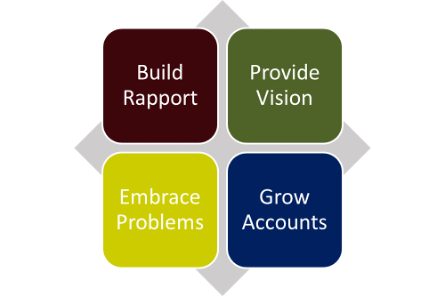In a previous blog, we introduced the idea that Client Management does not “just happen”…it must be deliberate and proactive in order to be effective. And while there are many key roles needed for the success of a PS business, there is an overarching role that is important for every consulting professional: your role as a guide. This role is more of a mindset, and we often find it is helpful and valuable to think of PS as a guide to communicate to others why Client Management skills are necessary and how they get applied in the real world.
As we stated in our previous blog, the best and most impactful guides all have the same commonalities. They:
- Build Rapport
- Provide Vision
- Embrace Problems
- Grow Accounts (i.e., expand relationships)

A successful guide must Build Rapport, and a key way to do this is to not waste a client’s time and to ensure that you add value to every conversation, regardless of the level of the person you are speaking to. Another effective way to build rapport and to reach your client is by picking up on his or her queues (i.e., likes a positive approach, likes a factual approach, is easily frustrated with details) and adapting your own natural communication style to meet your audience’s needs. Additional actions to build rapport with your clients are:
-
-
- Listening and having a sincere interest in each person as an individual
- Touching base frequently with people on the same level and assuring open dialog
- Not using jargon and being careful not to be arrogant
- Following through on all commitments – even minor ones
-
A successful guide must also Provide Vision. Remember, as a PS professional you are there to provide advice and guidance. It does no good if you shy away from providing your opinions. However, it also does little good if in doing so you alienate the client. Some actions to take to provide vision include:
-
-
- Providing mid-term vision to project meetings – For example, “In three months we need to be doing X. If the project continues behind schedule, I suggest we do Y. And I have some ideas of how to do Y if needed”.
- Providing workarounds for immediate issues
- Providing encouragement throughout a difficult implementation
- Provide an aura of “we know what we are doing and can be relied upon to get you through this”
- Providing ancillary advice not directly related to the project
- Being assertive with your opinions – the PS professional is there to provide advice
-
As a reminder, possessing the “Guide” mindset provides the foundation for what it is like to be a “consultant”. In the next blog on this topic, we will discuss the remaining two characteristics – Embrace Problems and Grow Accounts – in more detail.
Written by: Mark Slotnik
About the Author:
Mark Slotnik has spent nearly 20+ years advising clients in the areas of designing and taking to market high-value business solutions, solution portfolio management, talent development, resource management, business process re-engineering and commercial software.
